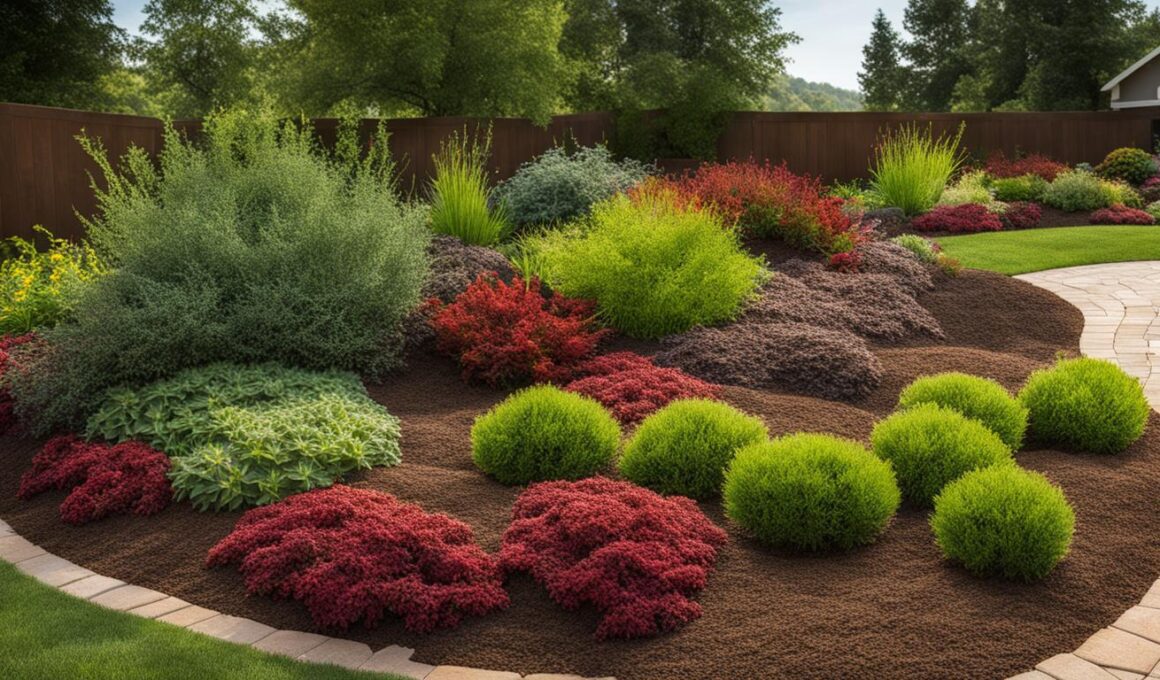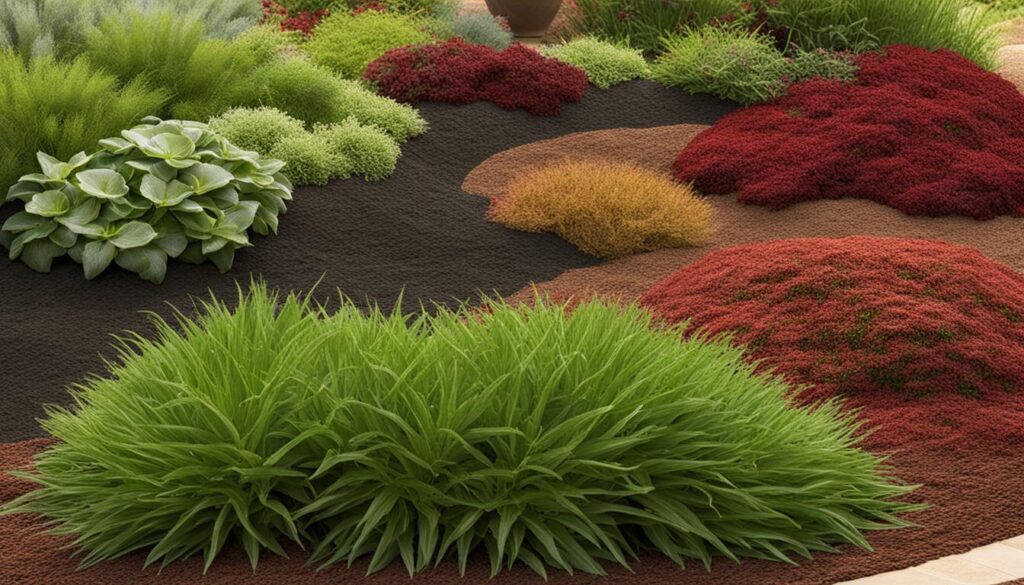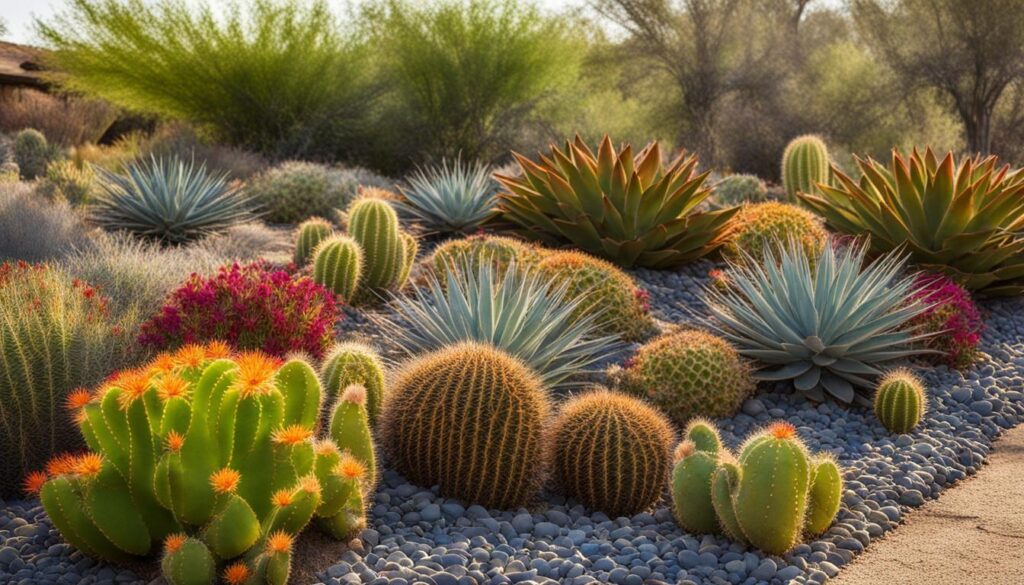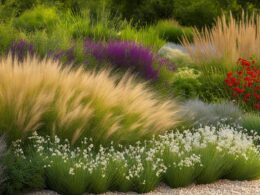Xeriscaping is a popular gardening practice that involves creating a landscape with plants that require minimal water. The principles of xeriscaping include water conservation, soil improvement, limited turf area, use of native plants, and the application of mulch. Layering mulch in xeriscaping practices is an essential component that helps retain moisture, suppress weeds, and maintain soil temperature. By mastering the art of layering mulch, you can enhance your landscape sustainably while conserving water, making it ideal for the American climate.
Key Takeaways
- Layering mulch in xeriscaping practices is crucial for water conservation and maintaining a sustainable landscape.
- Mulch helps retain moisture, suppress weeds, and regulate soil temperature in xeriscape gardens.
- Using organic mulch, such as wood chips or compost, provides additional benefits by adding nutrients to the soil.
- Layering mulch requires applying a thick layer and regularly replenishing it to maintain its effectiveness.
- Mastering layering mulch in xeriscaping practices can create a beautiful and low-maintenance landscape in the United States.
The Principles Behind Xeriscaping
Xeriscaping is a gardening technique that aims to conserve water, improve soil quality, and promote the use of native plants in landscaping. By following the principles of xeriscaping, you can create a sustainable and low-maintenance landscape that thrives in the American climate.
Water Conservation: One of the key principles of xeriscaping is reducing water use. By selecting drought-tolerant plants and implementing efficient irrigation methods like drip irrigation, you can significantly minimize water consumption in your landscape.
Soil Improvement: Xeriscaping focuses on improving soil quality to help plants thrive with minimal water. Adding organic matter, such as compost, to the soil enhances its water retention capacity and improves its structure. Testing the soil’s pH levels can also guide you in addressing any nutrient deficiencies.
Native Plants: Incorporating native plants into your xeriscape garden is essential for their adaptability to the local climate. Native plants are naturally suited to the region’s soil and weather conditions, making them more resistant to drought and requiring less maintenance.
| Xeriscaping Principles | Description |
|---|---|
| Water Conservation | Reducing water use by selecting drought-tolerant plants and efficient irrigation methods like drip irrigation. |
| Soil Improvement | Enhancing soil quality through the addition of organic matter and addressing nutrient deficiencies. |
| Native Plants | Incorporating plants native to the region for their adaptability and low maintenance requirements. |
By understanding the principles behind xeriscaping, you can create a beautiful and sustainable landscape that conserves water, improves soil health, and supports native plant species. Implementing these principles in your gardening practices will not only benefit your landscape but also contribute to water conservation efforts in the United States.
Benefits of Xeriscape Gardening
Xeriscape gardening offers numerous benefits that make it an appealing choice for homeowners in the United States. By adopting xeriscape practices, you can enjoy a beautiful and sustainable landscape while conserving water and minimizing maintenance. Let’s explore some of the key benefits of xeriscape gardening:
1. Water Conservation
Water conservation is a top priority in xeriscape gardening. Traditional gardening methods often require frequent watering, leading to high water consumption. With xeriscape gardening, you can reduce water use by 50-75% compared to traditional techniques. By planting drought-resistant plants and implementing efficient irrigation methods, such as drip irrigation, you can achieve significant water savings without compromising the health and beauty of your landscape.
2. Low Maintenance
One of the biggest advantages of xeriscape gardening is its low maintenance requirements. Xeriscape landscapes are designed to be sustainable and self-sufficient, minimizing the need for constant upkeep. By using native plants that are well-suited to the local climate and soil conditions, you can create a landscape that thrives with minimal intervention. Additionally, the use of mulch helps suppress weeds and retain moisture, further reducing the need for regular maintenance tasks like weeding and watering.
3. Environmental Friendliness
Xeriscape gardening is an environmentally-friendly choice for landscaping. By using native plants, you can reduce or eliminate the need for pesticides and fertilizers, minimizing the impact on local ecosystems. Native plants are adapted to the local climate and soil conditions, making them naturally resilient and less susceptible to pests and diseases. Additionally, xeriscape gardens provide a habitat for wildlife, attracting birds, butterflies, and beneficial insects that contribute to a thriving ecosystem.
In conclusion, xeriscape gardening offers an array of benefits, including water conservation, low maintenance requirements, and environmental friendliness. By implementing xeriscape practices in your landscape, you can create a sustainable and beautiful garden that enhances the beauty of your home while minimizing water usage and maintenance efforts.
Water Conservation in Xeriscaping
Water conservation is a fundamental principle of xeriscaping, and it plays a crucial role in creating a sustainable landscape. By incorporating water-saving techniques and selecting drought-resistant plants, you can significantly reduce water consumption in your xeriscape garden.
To conserve water effectively, it is essential to choose plants that are well-suited to the local climate and require minimal irrigation. Drought-resistant plants, such as native grasses, succulents, and cacti, are excellent choices for xeriscaping. These plants have adapted to survive in arid conditions and can thrive with less water.
In addition to plant selection, proper planning and design can further minimize water use. Identifying areas of shade and sun, marking drainage patterns, and grouping plants with similar water needs can help optimize irrigation and prevent water wastage. Efficient irrigation methods like drip irrigation and soaker hoses deliver water directly to the roots, reducing evaporation and ensuring that every drop counts.
Implementing these water conservation techniques in your xeriscape garden not only helps conserve a precious resource but also promotes environmental sustainability. By reducing water usage, you can contribute to water conservation efforts and create a beautiful, low-maintenance landscape that is resilient to drought conditions.
Soil Improvement in Xeriscaping
In xeriscaping, soil improvement plays a crucial role in creating a landscape that can thrive with minimal water. By enriching the soil with organic matter, such as compost, you can enhance its water retention capabilities and improve its overall structure. Organic matter acts as a sponge, absorbing and holding moisture for longer periods, reducing the need for frequent watering.
Moreover, adding organic matter to the soil promotes the growth of beneficial microorganisms, which aid in nutrient cycling and soil aeration. These microorganisms break down organic materials, releasing essential nutrients that nourish xeriscape plants. As a result, your plants will have access to the nutrients they need to thrive, even in lean soils.
Testing the pH levels of your soil is also important in xeriscaping. This analysis provides valuable insights into the nutrient content of the soil and identifies any deficiencies that need to be addressed. By adjusting the pH levels, you can create an optimal environment for your plants, ensuring they can absorb nutrients effectively.
Benefits of Soil Improvement in Xeriscaping
The benefits of soil improvement in xeriscaping are numerous. By enhancing the water-holding capacity of the soil, you can reduce the frequency of irrigation, saving both water and time. Additionally, improving soil structure promotes better root development and root penetration, allowing plants to access water and nutrients more effectively.
Enriching the soil with organic matter also enhances its ability to drain excess water. This is especially important in arid regions where heavy rainfall may occur infrequently but can lead to soil erosion. By improving soil drainage, you can prevent waterlogging and ensure that your xeriscape plants are not subjected to excessive moisture, which can be detrimental to their health.
| Benefits of Soil Improvement in Xeriscaping | |
|---|---|
| Enhanced water retention | Less frequent watering |
| Promotes nutrient cycling | Healthier, more nourished plants |
| Improved soil structure | Better root development |
| Optimal soil pH | Effective nutrient absorption |
| Enhanced soil drainage | Prevents waterlogging and erosion |
Xeriscape Plants for Soil Improvement
When selecting xeriscape plants for soil improvement, consider those with deep root systems and the ability to tolerate various soil conditions. Native plants are often ideal choices as they are well-adapted to the local climate and soil conditions. Succulents, such as agaves and yuccas, are excellent options as they have shallow root systems that help stabilize the soil and prevent erosion.
Grasses like buffalo grass and blue grama grass can also contribute to soil improvement. Their dense root systems create channels that enhance water infiltration and improve soil structure. Furthermore, leguminous plants, such as clover and lupine, are beneficial as they fix nitrogen in the soil, enriching it with this essential nutrient.
By focusing on soil improvement in your xeriscape garden, you can create a thriving and sustainable landscape that requires less water and maintenance. The addition of organic matter, testing soil pH, and selecting appropriate xeriscape plants will ensure that your soil is enriched, promoting the health and longevity of your xeriscape garden.
Using Mulch in Xeriscaping
In xeriscaping practices, mulch plays a vital role in maintaining a sustainable and water-efficient landscape. Mulch not only helps retain moisture but also regulates soil temperature, suppresses weed growth, and prevents soil erosion. By applying a layer of mulch several inches thick, you can enjoy the many benefits it provides while reducing the need for excessive irrigation and maintenance.
Organic mulch, such as wood chips or compost, is recommended for xeriscape gardens. As it gradually decomposes, organic mulch adds valuable nutrients to the soil, improving its overall fertility. Additionally, organic mulch acts as a natural weed barrier, reducing the need for chemical herbicides. It creates an unfavorable environment for weed germination and growth, allowing your xeriscape plants to thrive without competition.
Regularly replenishing the mulch layer is important to maintain its effectiveness. Over time, mulch can break down and lose its beneficial properties. By refreshing the mulch layer annually, you can ensure that it continues to provide adequate moisture retention, weed control, and protection against soil erosion. Remember to apply mulch only around the base of your plants, leaving a small gap to prevent moisture-related issues and diseases.
| Mulch Benefits in Xeriscaping | Mulch Type |
|---|---|
| Moisture Retention | Organic mulch (wood chips, compost) |
| Weed Control | Organic mulch (wood chips, compost) |
| Soil Temperature Regulation | Organic mulch (wood chips, compost) |
| Soil Erosion Prevention | Organic mulch (wood chips, compost) |
By utilizing mulch in your xeriscape garden, you can create an aesthetically pleasing and environmentally friendly landscape. The layer of mulch not only adds visual appeal but also delivers essential benefits that contribute to the overall health and sustainability of your xeriscape plants.
Mulch Tips for Xeriscaping:
- Apply a layer of mulch several inches thick around the base of your xeriscape plants.
- Use organic mulch, such as wood chips or compost, to enrich the soil and provide long-term benefits.
- Regularly replenish the mulch layer to maintain its effectiveness in retaining moisture and controlling weeds.
- Leave a small gap between the mulch and plant stems to prevent moisture-related issues.
- Avoid using mulch in excess, as a thick layer can create a barrier that hampers water penetration.
- Choose mulch materials that are readily available and suitable for your local climate and xeriscape plants.
“The use of mulch in xeriscaping practices significantly contributes to water conservation and weed control, making it an essential component for maintaining a sustainable landscape.” – Xeriscape Gardening Magazine
What are the Best Mulching Techniques for Xeriscaping in the U.S.?
When xeriscaping in the U.S., it is essential to master mulching techniques for xeriscape. Use organic mulch like wood chips or bark to retain soil moisture and suppress weeds. Inorganic mulch like gravel or pebbles also works well for conserving water and protecting plants in a xeriscape garden.
Conclusion
Layering mulch in xeriscaping practices is a key technique for creating a sustainable and water-efficient landscape. By following the principles of xeriscaping, including water conservation, soil improvement, limited turf area, use of native plants, and the application of mulch, you can enhance your landscape while conserving water and minimizing maintenance.
Layering mulch provides multiple benefits such as moisture retention, weed control, and soil temperature regulation. By creating a layer of mulch several inches thick, you can effectively retain moisture in the soil, preventing water evaporation and reducing the need for frequent watering. The mulch layer also acts as a barrier, suppressing the growth of weeds and reducing the time and effort required for maintenance.
In addition, layering mulch helps regulate soil temperature, keeping it cooler during hot summer months and preventing extreme temperature fluctuations that can stress plants. This is especially important in xeriscape gardens, where plants need to withstand the challenges of the American climate.
By mastering the art of layering mulch in xeriscaping practices, you are creating a beautiful and sustainable landscape that is in harmony with nature. With its ability to conserve water, control weeds, and maintain soil temperature, layering mulch is an essential technique for achieving a thriving xeriscape garden—ideal for sustainable landscaping in the United States.













